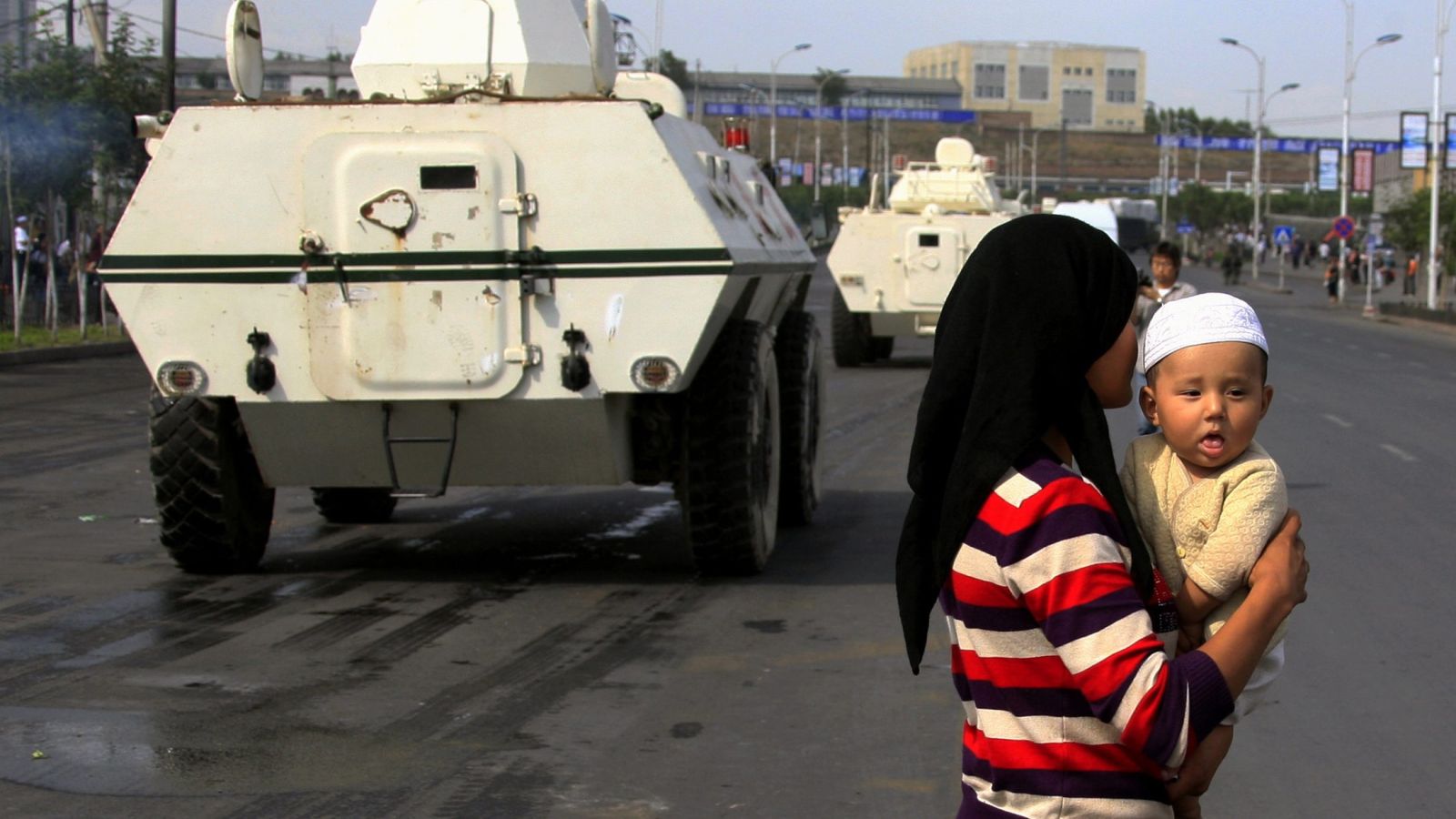China created a new terrorist threat by repressing secessionist fervor in its western frontier

Quartz, 1 June 2017

By Lindsey Kennedy & Nathan Paul — In the early hours of New Year’s Day in 2017, a heavily armed gunman stormed Reina, an exclusive Istanbul nightclub on the Bosphorus coast, murdering 39. ISIS claimed responsibility for the massacre, but the Turkish deputy prime minister swiftly made an incendiary claim: the perpetrators, he said, were “probably” Uyghur—the ethnically Turkic Muslims indigenous to the region of northwest China officially called the Xinjiang Uyghur Autonomous Region.
Two Uyghur Chinese nationals, Omar Asım and Abuliezi Abuduhamiti, were arrested on charges of being members of a terrorist cell and acting as accomplices to the attack. (An Uzbek national has since been detained and named as the alleged gunman.) Meanwhile, the World Uyghur Congress claims hundreds of other Uyghurs were arrested, with little explanation, in subsequent raids.
Why ISIS would target Istanbul is simple: The city is the secular-leaning cultural and financial capital of a country the group holds responsible for numerous attacks (paywall) on ISIS targets.
But Uyghurs are moderate Muslims with an extremely close and positive historical relationship with Turkey. Their alleged involvement is harder to parse. Over China’s turbulent 69-year rule of Xinjiang, periods of violent repression—as well as antagonistic policies such as restrictions on worship and religious attire, the ban of traditional Muslim names, and the requirement that all residents turn in their passports—have kept Uyghur secessionist sympathies bubbling along the frontier. Throughout, Turkey has always been the Uyghurs’ most ardent supporter.
Through the 1990s and 2000s, successive Turkish governments continued to welcome Chinese Uyghurs, much to China’s annoyance; some 300,000 who escaped persecution in China now call Turkey home. Pro-Uyghur sentiment has, at times, exploded into violent protest, and government ministers have openly criticized China’s treatment of the group.
Even Turkey appears to now be under the sway of Asia’s economic powerhouse. Until recently, Turkey’s suspicions that Uyghurs would terrorize Istanbul would make no sense. For years, China has treated Uyghurs like terrorists even though they could have cared less about jihad. But in the past few years, China has wielded its growing regional power to bring its neighbors in line with Beijing’s anti-Uyghur policies. Even Turkey appears to now be under the sway of Asia’s economic powerhouse. Facing repression at home, and with nowhere left to go, some of those Uyghurs have been forced into dangerous new alliances with organizations like ISIS. After decades of crying wolf, China may very well have created the conditions that allowed terrorism to take root in its own soil.
The first encounters
For centuries, despite multiple rebellions by the Uyghurs, control of what is now Xinjiang shifted between the Qing dynasty and rival Chinese warlords.
In the 1940s, the Uyghurs enlisted the help of the Soviet Union to create a separatist state, called the East Turkestan Republic. As close cultural and ethnic cousins of the Uyghurs, the Turkish lent a hand in the administrative and cultural shaping of the republic. It didn’t last; five years later, the USSR’s loyalties switched to Chairman Mao, and the Russians helped The Communist People’s Liberation Army recapture the nascent state. In October 1949, East Turkestan was absorbed into Communist China.

The mostly rural Uyghur communities were decimated by Mao’s agricultural policies, which triggered a famine and the 1962 exodus of 60,000 Uyghur refugees into the USSR. Cultural identity was all but exterminated as Uyghur-language schools and customs, as well as Islamic religious practices, were outlawed. Resistors were crushed.
State-orchestrated mass migration brought millions of Han Chinese into Xinjiang in an attempt to dilute the Uyghur population. Ethnic tensions soared from the 1950s to the 1970s, when state-orchestrated mass migration (pdf) brought millions of Han Chinese into Xinjiang in an attempt to dilute the Uyghur population. Beijing continues to encourage Han movement into the region; the typically strict rules limiting internal migration in China are relaxed for this specific ethnic group and destination. Han Chinese now make up 58% of the Xinjiang population, up from just 6% in 1949.
At the same time, Beijing poured money into Xinjiang, transforming the provincial capital, Urumqi, into a modern city and thriving business center, extending a national train network into the region and restoring the exquisite Islamic architecture of the city of Kashgar, the spiritual center of traditional Uyghur culture.
Today, the walls of Kashgar’s winding streets are inscribed with Koranic verses under latticed arches. Uyghur bookshops abound. Women on motorbikes and dressed in the unique local style—long dresses, elaborately arranged headscarves, kohl-lined eyes, high-heeled boots—weave past market traders dishing out spicy chickpeas, lamb kebabs, and freshly cooked bread.

It’s hard to believe you’re in China—and, as far as many Uyghurs are concerned, you aren’t. Despite generations of suppression and “re-education,” people here were never truly assimilated into Chinese identity. If anything, the limited freedoms offered by Beijing intensified, rather than assuaged, secessionist fervor (pdf).
From the late 1980s, as the Soviet Union began to collapse, Uyghurs watched as, one by one, their closest cousins just across the border—Kyrgyz, Kazakhs, Uzbeks, Tajiks—achieved independent states. If the Communist superpower next door could give way, the Uyghurs thought, why not China? Emboldened, Uyghurs renewed calls for Xinjiang to reclaim its independence under the name East Turkestan or Uyghurstan. In 1990, dissent erupted into riots, and Beijing ordered the first of many brutal crackdowns.
For a while, the brand-new neighboring Central Asian states provided an escape route. Kyrgyzstan and Kazakhstan have sizeable indigenous Uyghur populations, and their languages and cultures are closely related, making these countries a logical destination for Uyghurs seeking a new life outside China.
But in 1996, Kazakhstan and Kyrgyzstan joined the Shanghai Cooperation Organisation, a powerful Sino-Russian initiative to strengthen regional alliances and solve border disputes. Immediately, these states began not only shutting down Uyghur organizations (particularly those calling for greater autonomy for Xinjiang), but also became increasingly amenable both to extraditing Uyghur “terror suspects” on weaker and weaker evidence, and blaming Uyghurs for domestic attacks with little to substantiate these claims. Turkey remained the one country to provide safe harbor for Ughyurs seeking political asylum.
It was during this period that Uyghur separatists first began to encounter Islamic terrorists.
What began as the ETIM gradually transformed into a pro-jihadist faction fighting alongside Al-Nusra in Syria today. For decades, the East Turkestan Islamic Movement (ETIM) operated as a barely organized collective of secessionists (who had been falsely portrayed as a major Islamist terror threat by the Chinese), says Sean Roberts, a professor at George Washington University and author of a forthcoming book on the impact of Chinese oppression and the US War on Terror on the emergence of Uyghur terrorism. Facing mounting repression and dwindling options in the 1990s, some ETIM members fled to Pakistan and Afghanistan where they agreed to train with Al-Qaeda—whose ideology they knew little about—in the hope of gaining the skills “to someday fight a war of liberation” in Xinjiang. What began as the ETIM gradually transformed into a pro-jihadist faction fighting alongside Al-Nusra (formerly the Syrian faction of Al-Qaeda) in Syria today.
That said, as late as 2002, ETIM founder Hasan Mahsum insisted that the group was not anti-American and only sought independence from China. Following his death the next year, the ETIM went silent, and appears to have splintered. In 2008, one of those splinters resurfaced, calling itself the Turkestan Islamic Party (TIP), and specifically recruiting Uyghurs to fight for global jihad. Al-Qaeda leader Ayman al-Zawahiri even released a video praising TIP fighters for their commitment to the cause and calling for Uyghurs to “strengthen the fire of jihad” against the “atheist Chinese invaders”—re-framing a secessionist struggle as jihadist.
Uyghurs without passports
Meanwhile, back home in Xinjiang, life did not improve for Chinese Uyghurs.
Many complained that the Han Chinese who kept flooding into the cities of Xinjiang showed little respect for their beliefs and customs, while excluding them from well-paying jobs. At the same time, China launched its “Strike Hard” campaign, suppressing more fiercely than ever Uyghurs’ freedom of speech, religion, and movement.
In 1997, a demonstration turned into a riot in Ghulja, an oasis town in Xinjiang, and police opened fire on the crowd. In the ensuing crackdown, thousands were arrested and hundreds executed. Around one in every 10 men from the area disappeared without trace or official explanation, says Joanne Smith Finley, a professor of Chinese studies at Newcastle University, who has conducted extensive research in the area.
Chinese law still restricts everything from children attending mosque to men growing beards. Brutal stories proliferate of detention, torture, and women forced to endure late-term abortions to comply with China’s (now-lifted) one-child policy—from which Uyghurs were supposed to be exempt.

According to Nicole Morgret of the Washington, DC-based Uyghur Human Rights Project, Uyghurs routinely have passports seized and kept for “safekeeping,” especially when travelling—much like their Tibetan neighbors. Chen Quanguo, who took over as party secretary of Xinjiang in August 2016, formerly controlled Tibet, and is already deploying similarly intense security and surveillance tactics to contain and isolate Uyghurs, Morgret says.
Movement beyond Urumqi is monitored and restricted; airport-style security and Chinese-only self-service machines at the hectic train station mean Uyghurs often wait an entire afternoon to buy a ticket from the handful of human tellers. Identification is required to enter stations and purchase tickets, trapping those whose passports have been refused or confiscated.
But unlike oft-romanticized Tibetan Buddhists, Muslim Uyghurs rarely attract the same support or sympathy from the West. While both groups share the same grievances—they resent Chinese control and fear the obliteration of their culture, language, and religious freedom—rising paranoia in the US and Europe over Islamic extremism has made it far too easy for Beijing to win support by portraying Uyghur dissidents as an Islamist threat. When the US began to wage its War on Terror, this turned out to be a gift to Chinese domestic policy—and devastating for Uyghurs in China and abroad.
The War on Terror terrorizes
A month after 9/11, 22 Uyghur men who fled across the border into Afghanistan and took refuge in a Taliban village were captured by mercenaries and sold to US forces. The narrative wasn’t new. Faced with domestic travel restrictions and a lack of sympathetic neighbors, impoverished Uyghurs escaping persecution in Xinjiang have often resorted to braving the treacherous mountain pass into Afghanistan. Without any form of documentation, many find the only places that will take them in are Taliban-held tribal areas, or camps used to train terrorist networks like Al-Qaeda and Al-Nusra.
As one captive, Abu Bakker Qassim told Al Jazeera after his release:
All of us who stayed there had great respect for the Afghan people, and the Taliban, because no one else provided refuge to the Uyghur people. You didn’t need a passport or anything else. Even if you were not making any money you still had three meals a day. I’m still grateful to them. No other country has given Uyghur refugees anything like that.
The US eventually admitted its mistake—the Uyghurs posed no threat—but not until all 22 had been held for 12 years in Guantanamo Bay.
“This business about Uyghurs being Islamic terrorists is total garbage” When the US invaded Afghanistan in 2001, the US sought, and secured, Beijing’s support for its retaliatory strikes—the first time China had collaborated with US military aims since the Cold War. In return—offering no independent evidence beyond China’s unproven claims (paywall)—the US added four Uyghur groups to the US terror watchlist. “This business about Uyghurs being Islamic terrorists is total garbage,” says Pannier. “They are nationalists that just happen to be Muslim. The Chinese put too much weight on the latter part and say they are part of extremist groups.” Chinese state propaganda seized on America’s labeling of Uyghur groups as terrorists to legitimize persecution of Uyghurs of all political stripes—at home, and abroad.
China stepped up demands that Uyghurs be extradited (pdf) from Uzbekistan, Kyrgyzstan, Kazakhstan, Russia, Nepal, and Pakistan. In 2014, Kyrgyz border guards gunned down 11 Uyghurs; China and Kyrgyzstan claimed they were “separatists” based on reports that their bags contained a Quran and some knives. In 2015, two Uyghurs were shot trying to cross into Vietnam, 20 were deported from Cambodia amid international outcry, and Thailand was persuaded to forcibly return 109 Uyghurs attempting to travel through the country from China to Turkey—the only reliable sanctuary remaining to them.
Ironically, since the mid-2010s, ISIS has set its sights on Uyghur recruits. In recent years, a small number of Uyghurs have undergone military training in ISIS camps. Registration documents leaked by an ISIS defector in 2016 showed that 114 Chinese Uyghurs joined the group between mid-2013 and mid-2014. Many were children; some were as old as 80; and all were poor and uneducated, suggesting that a significant proportion of these are whole families of Uyghurs who believed the group would provide refuge and support. But there’s a real possibility some of ISIS’ Uyghur recruits will pose a future terrorist threat to China.
“In the past it was perhaps overblown, but China’s fears [of organized terrorism] have now been realized,” says Dru Gladney, professor of anthropology at Pomona College and an expert in Muslim Chinese identity politics.
The timing could not be worse.
Xinjiang shares borders with India, Russia, Mongolia, Kazakhstan, Kyrgyzstan, Tajikistan, Afghanistan, and Pakistan. This makes it the focal point of premier Xi Jinping’s “One Belt, One Road” initiative to connect China to Central Asia and beyond via an elaborate series of roads, tunnels, bridges, and high-speed rail networks. For the project to succeed, China will need to convince investors the region is stable—that the nonexistent terrorist threat Beijing trumpeted for decades has conveniently disappeared.
But now the threat is real, and will likely grow as borders become more porous and tensions escalate in Xinjiang. “It will increase resentment,” says Morgret. “The Chinese think developing Xinjiang and reducing poverty will solve the problem, but it’s creating the problem by bringing in new migrants and pushing away Uyghurs.”
The last door closes
And then there’s Turkey.
Until recently, it would have made little sense for anyone to even claim that an Uyghur would be involved in an attack on the one country that has always welcomed them. But political and economic chaos, the Syrian war on its doorstep, and the receding prospect of being welcomed into the EU have made collaboration with the superpowers of Russia and China vastly more attractive to president Recep Tayyip Erdoğan’s government than they ever were in the past few decades. Erdoğan has openly admitted that joining the Shanghai Cooperation Organisation rather than the EU would allow him to operate with “greater ease.”

In July 2015, during negotiations over investment in infrastructure, anti-terrorism strategy, and plans to raise bilateral trade to $100 billion, China made clear to Turkey (paywall) that open criticism of its treatment of Uyghurs—and even continuing to offer asylum to those fleeing the country—would make it “very hard” for the relationship to thrive.
Sixteen months later, amid rising fears of ISIS-sponsored terror attacks in Turkey, Chinese foreign minister Wang Yi flew to Ankara to meet with his Turkish counterpart Mevlut Cavusoglu. In a statement released after the November 2016 meeting, the Chinese ministry of foreign affairs explained that “both sides promise to firmly support each other’s efforts in maintaining national sovereignty, security, and stability” and will “never allow any events that could hurt the other country’s national security in their own territory.” Policy analysts had already noted that politicians anxious to improve business ties with China were increasingly dismissive of Turkish “sentimentality” over their kinship and loyalty to the Uyghurs, and these lines were understood by Gladney and others to imply that Turkey would drop opposition to, or even assist with, China’s Uyghur policies.
The statement also confirmed that the two countries were finally ready to push forward with the construction of a long-discussed, economy-boosting high-speed rail line.
Six weeks later, as Istanbul reeled from the the New Year’s Day attack, Turkey’s deputy prime minister lost no time in speculating that the attack was Uyghur-orchestrated.
After years of rebuffing Chinese pressure to crackdown on Uyghurs, Turkey is at last toeing the line. After years of rebuffing Chinese pressure to crackdown on Uyghurs, Turkey is at last toeing the line. If, like its Central Asian neighbors, Turkey begins to scapegoat, marginalize, and extradite Uyghurs at China’s behest, they have lost their final safe haven. For Uyghurs fleeing Chinese repression, there is nowhere left to turn but the jihadist factions that are more than willing to take them in.
The repercussions are already clear. On Feb. 27, 2017, ISIS released a video specifically targeting China. In it, a Uyghur member pledges allegiance to the caliphate and threatens to flood the motherland with “rivers of blood,” while heavily armed Uyghur children are shown training, giving speeches, and even executing an “informant”, according to SITE Intelligence, the US agency that analyzed and translated the footage.
While militant Uyghur secessionists have used violence in the past, never before have Uyghur groups framed their struggle with China as jihadist. And never before have their threats been backed by an organized international network with a history of successful terror attacks. At last, China, as well as the rest of the world, has genuine reason to fear: as children come of age under the tutelage of ISIS, and if they manage to return to their motherland, these children and teenagers could constitute a very real, and very serious, terrorist threat.
“Uyghur terrorism has become a self-fulfilling prophecy,” says Roberts. “China has created the threat they long claimed to face.”

